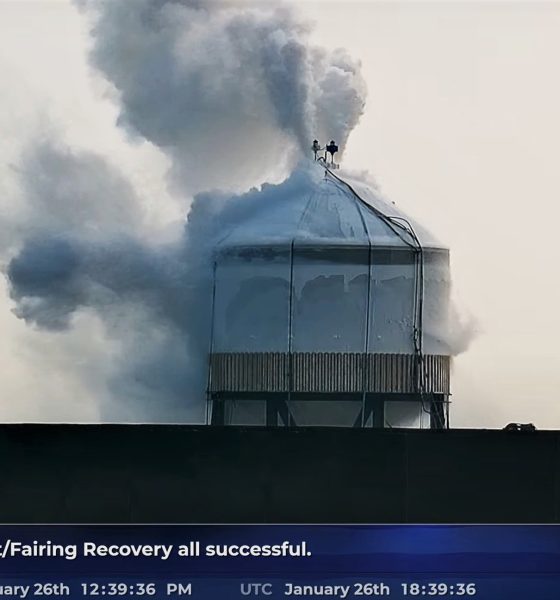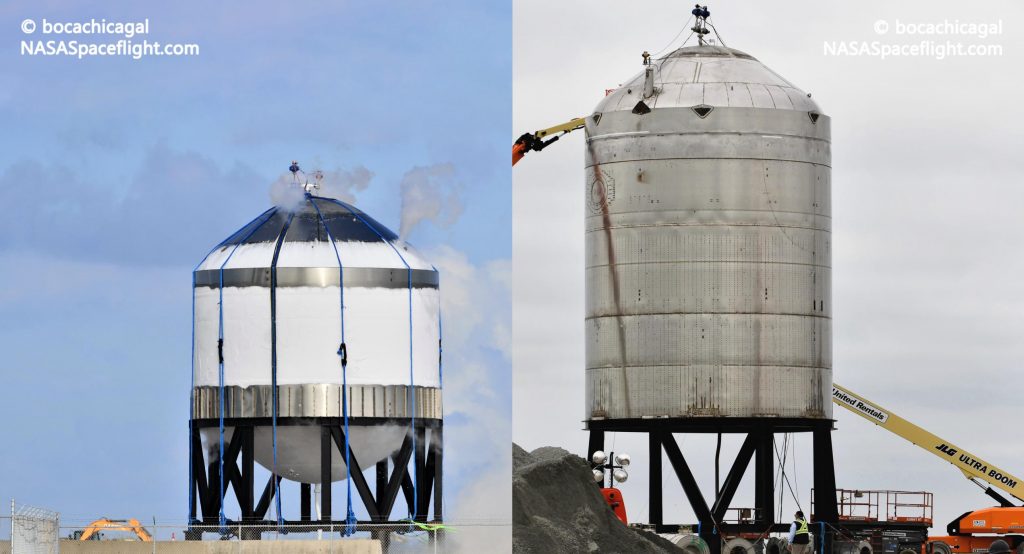

News
SpaceX’s thin-skinned Starship ‘test tank’ passes first trial
CEO Elon Musk says that a new thin-skinned Starship ‘test tank’ just passed its first trial, taking advantage of delays to Starship SN9’s planned high-altitude launch debut.
Delayed by a lack of FAA approval for unknown reasons, Starship SN9’s 12.5-kilometer (7.8 mi) launch debut (virtually identical to SN8’s 12.5 km launch last month) is in limbo pending an “FAA review” according to Musk. SpaceX thus found itself with at least 24 hours of guaranteed inactivity for Starship SN9, time the company rapidly chose to fill with crane transportation and, more importantly, the first Starship ‘test tank’ stress test in months.
Known as Starship SN7.2, SpaceX’s latest ‘test tank’ is the third to carry the SN7 moniker and appears to have been built primarily to test refinements to the rocket’s structural design. Following test tanks SN7.0 and SN7.1, both used to qualify the use of a new steel alloy on an otherwise unchanged design, SN7.2 – likely built out of the same alloy – is instead focused on determining if SpaceX can begin trimming the margins of an increasingly mature technology.


Curiously, SN7.2 is a sort of fusion of its predecessors: combining the stout stature of SN7.0 with SN7.1’s use of an aft thrust dome, but without SN7.1’s Starship-style skirt (the three rings at its bottom). Welded directly to its black test stand, it’s unclear why SpaceX chose to give SN7.2 a thrust dome, given that the thrust of Raptor engines can only be simulated with hydraulic rams if the tank is installed on one of two Starship launch mounts.
Regardless, whether SpaceX actually tests that aspect of SN7.2, the tank’s most important task is determining if future Starships (and perhaps Super Heavy boosters) can be built out of thinner, lighter steel rings. Its domes appear to be identical to past ships but writing on the exterior of the tank strongly implied that its three rings were built out of 3mm steel rather than the 4mm sheets that have made up every Starship built in the last 12 months.
SpaceX began loading the thin-skinned tank with liquid nitrogen (used to simulate cryogenic propellant without the risk of an explosion) around 9am CST and spent around three hours performing an “initial pressure test.” It’s unclear what that test entailed but it most likely involved raising the tank’s internal pressure to levels achieved by SN7.0 and SN7.1 Musk has previously said that that 6 bar was the bare minimum necessary for orbital flight, translating to 7.5-8.5 bar to achieve an industry-standard safety margin of 25-40%.
That SN7.2 survived that initial pressure test bodes well for the significant mass reductions SpaceX will need to optimize Starships for efficient orbital flight, potentially shaving 5-10 metric tons off the dry mass of future ships. For orbital rocket stages, every single kilogram of mass reduction translates to an extra kilogram of cargo capacity, whereas boost stages (i.e. Super Heavy) offer far more lenient ratios on the order to 10:1, meaning that adding 5-10 kilograms of rocket hardware reduces maximum payload capacity by just ~1 kg.
Depending on when SpaceX is allowed to launch Starship SN9, the company’s next test could involve pressurizing SN7.2 until it bursts, determining if the tank’s thinner skin substantially impacts its performance as a pressure vessel.

News
Tesla FSD v14.2.2 is getting rave reviews from drivers
So far, early testers have reported buttery-smooth drives with confident performance, even at night or on twisty roads.

Tesla Full Self-Driving (Supervised) v14.2.2 is receiving positive reviews from owners, with several drivers praising the build’s lack of hesitation during lane changes and its smoother decision-making, among others.
The update, which started rolling out on Monday, also adds features like dynamic arrival pin adjustment. So far, early testers have reported buttery-smooth drives with confident performance, even at night or on twisty roads.
Owners highlight major improvements
Longtime Tesla owner and FSD user @BLKMDL3 shared a detailed 10-hour impression of FSD v14.2.2, noting that the system exhibited “zero lane change hesitation” and “extremely refined” lane choices. He praised Mad Max mode’s performance, stellar parking in locations including ticket dispensers, and impressive canyon runs even in dark conditions.
Fellow FSD user Dan Burkland reported an hour of FSD v14.2.2’s nighttime driving with “zero hesitations” and “buttery smooth” confidence reminiscent of Robotaxi rides in areas such as Austin, Texas. Veteran FSD user Whole Mars Catalog also demonstrated voice navigation via Grok, while Tesla owner Devin Olsen completed a nearly two-hour drive with FSD v14.2.2 in heavy traffic and rain with strong performance.
Closer to unsupervised
FSD has been receiving rave reviews, even from Tesla’s competitors. Xpeng CEO He Xiaopeng, for one, offered fresh praise for FSD v14.2 after visiting Silicon Valley. Following extended test drives of Tesla vehicles running the latest FSD software, He stated that the system has made major strides, reinforcing his view that Tesla’s approach to autonomy is indeed the proper path towards autonomy.
According to He, Tesla’s FSD has evolved from a smooth Level 2 advanced driver assistance system into what he described as a “near-Level 4” experience in terms of capabilities. While acknowledging that areas of improvement are still present, the Xpeng CEO stated that FSD’s current iteration significantly surpasses last year’s capabilities. He also reiterated his belief that Tesla’s strategy of using the same autonomous software and hardware architecture across private vehicles and robotaxis is the right long-term approach, as it would allow users to bypass intermediate autonomy stages and move closer to Level 4 functionality.
News
Elon Musk’s Grok AI to be used in U.S. War Department’s bespoke AI platform
The partnership aims to provide advanced capabilities to 3 million military and civilian personnel.

The U.S. Department of War announced Monday an agreement with Elon Musk’s xAI to embed the company’s frontier artificial intelligence systems, powered by the Grok family of models, into the department’s bespoke AI platform GenAI.mil.
The partnership aims to provide advanced capabilities to 3 million military and civilian personnel, with initial deployment targeted for early 2026 at Impact Level 5 (IL5) for secure handling of Controlled Unclassified Information.
xAI Integration
As noted by the War Department’s press release, GenAI.mil, its bespoke AI platform, will gain xAI for the Government’s suite of tools, which enable real-time global insights from the X platform for “decisive information advantage.” The rollout builds on xAI’s July launch of products for U.S. government customers, including federal, state, local, and national security use cases.
“Targeted for initial deployment in early 2026, this integration will allow all military and civilian personnel to use xAI’s capabilities at Impact Level 5 (IL5), enabling the secure handling of Controlled Unclassified Information (CUI) in daily workflows. Users will also gain access to real‑time global insights from the X platform, providing War Department personnel with a decisive information advantage,” the Department of War wrote in a press release.
Strategic advantages
The deal marks another step in the Department of War’s efforts to use cutting-edge AI in its operations. xAI, for its part, highlighted that its tools can support administrative tasks at the federal, state and local levels, as well as “critical mission use cases” at the front line of military operations.
“The War Department will continue scaling an AI ecosystem built for speed, security, and decision superiority. Newly IL5-certified capabilities will empower every aspect of the Department’s workforce, turning AI into a daily operational asset. This announcement marks another milestone in America’s AI revolution, and the War Department is driving that momentum forward,” the War Department noted.
News
Tesla FSD (Supervised) v14.2.2 starts rolling out
The update focuses on smoother real-world performance, better obstacle awareness, and precise end-of-trip routing, among other improvements.

Tesla has started rolling out Full Self-Driving (Supervised) v14.2.2, bringing further refinements to its most advanced driver-assist system. The new FSD update focuses on smoother real-world performance, better obstacle awareness, and precise end-of-trip routing, among other improvements.
Key FSD v14.2.2 improvements
As noted by Not a Tesla App, FSD v14.2.2 upgrades the vision encoder neural network with higher resolution features, enhancing detection of emergency vehicles, road obstacles, and human gestures. New Arrival Options let users select preferred drop-off styles, such as Parking Lot, Street, Driveway, Parking Garage, or Curbside, with the navigation pin automatically adjusting to the user’s ideal spot for precision.
Other additions include pulling over for emergency vehicles, real-time vision-based detours for blocked roads, improved gate and debris handling, and extreme Speed Profiles for customized driving styles. Reliability gains cover fault recovery, residue alerts on the windshield, and automatic narrow-field camera washing for new 2026 Model Y units.
FSD v14.2.2 also boosts unprotected turns, lane changes, cut-ins, and school bus scenarios, among other things. Tesla also noted that users’ FSD statistics will be saved under Controls > Autopilot, which should help drivers easily view how much they are using FSD in their daily drives.
Key FSD v14.2.2 release notes
Full Self-Driving (Supervised) v14.2.2 includes:
- Upgraded the neural network vision encoder, leveraging higher resolution features to further improve scenarios like handling emergency vehicles, obstacles on the road, and human gestures.
- Added Arrival Options for you to select where FSD should park: in a Parking Lot, on the Street, in a Driveway, in a Parking Garage, or at the Curbside.
- Added handling to pull over or yield for emergency vehicles (e.g. police cars, fire trucks, ambulances).
- Added navigation and routing into the vision-based neural network for real-time handling of blocked roads and detours.
- Added additional Speed Profile to further customize driving style preference.
- Improved handling for static and dynamic gates.
- Improved offsetting for road debris (e.g. tires, tree branches, boxes).
- Improve handling of several scenarios, including unprotected turns, lane changes, vehicle cut-ins, and school buses.
- Improved FSD’s ability to manage system faults and recover smoothly from degraded operation for enhanced reliability.
- Added alerting for residue build-up on interior windshield that may impact front camera visibility. If affected, visit Service for cleaning!
- Added automatic narrow field washing to provide rapid and efficient front camera self-cleaning, and optimize aerodynamics wash at higher vehicle speed.
- Camera visibility can lead to increased attention monitoring sensitivity.
Upcoming Improvements:
- Overall smoothness and sentience.
- Parking spot selection and parking quality.








